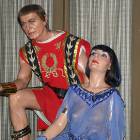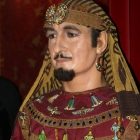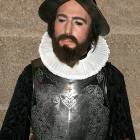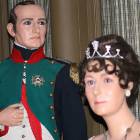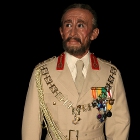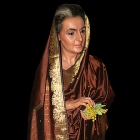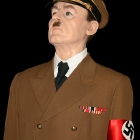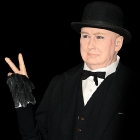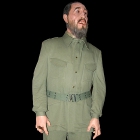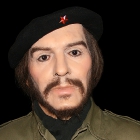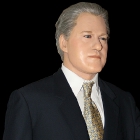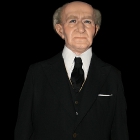3D portraits of dictators, royals, adventurers and other leaders
It’s strange to observe, but democratically elected presidents of the past don’t seem to stir up imagination as much as the villains of political scene. We love democracy, but those we choose freely look like dull little wheels in a complicated mechanism. While those who won’t let go their grip on power are painted like heroic characters of an adventure novel.
Also, one observed that democracies rarely go to war with one another, preferring to trade and engage in diplomatic negotiations. While strong leaders sometimes galvanize the energies of their country in ambitious directions, that end up in ultimatums and military confrontations. Not to mention that some came to power against all odds from humble background.
Next in line for public enthusiasm are members of royal families. In a more and more secular Europe, monarchies did not disappear, but are less a connection with the divine but more like socialite stars. The extreme case is the English one, where ironically the monarch is still the head of a church, but where tabloids play a key role in maintaining the glam around those of blue blood, managing to keep an aura of respectability in the same time.
their inoffensive wax versions
Some of the political figures we can admire and snap pictures with in Barcelona’s Wax Museum, cover the whole specter, from dictators, to monarchs and presidents. Their image in the minds of men changed much like the notion of dictatorship – which during the Roman Empire (that officially insisted to be called a Republic) ha no bad connotation.
A leader like Julius Caesar, that would style himself a dictator, implied nothing abusive. The term at that point was as innocent as “commander” and the same went for “imperator”, no king being embarrassed to expand his dominion to the state of an empire.
The titles were often more pompous as reality. The king or Iran, Rheza Pahlavi styled himself “shah in shah”, or the king of kings, in remembrance of the mighty power of Persian emperors, who had divine status. It was religion that came against him eventually, when the Islamic Revolution of 1979 brought in his place an unsuspecting cleric, the ayatollah Khomeini. With his bank assets seized by his former American allies, the shah was reduced to a vagabond, moving from country to country just for refuge.
Present as a wax statue is also a pharaoh. One of the ancient rulers of ancient Egypt, Ptolemy I, established the first recorded museum. It was a combination between a collection of art objects, a library and a place where music and poetry were performed. We should note that the Ptolemaic dynasty, founded by him, came in the very late stage of ancient Egypt, from 305 BC, in what is called the Hellenistic period.
Ptolemy was a Macedonian related to Alexander the Great so help spreading the Greek language and culture. It was from this dynasty that the famous Cleopatra was part of (some three centuries later). Her love story and political alliance with Mark Anthony is one of the romances of history.
The ”actual” pharaohs, that built the pyramids lived in the old kingdom, before 2.500 BC, the Egyptian history starting even before the year 3.000. Some pharaohs are famous in present day because their tombs survived without being robbed and golden masks or statues were found. Such is the case of Tutankhamun, Tutmose or Amenhotep, from the late period after 1.500 BC. Art saved them though they lived in a time of relative decline.
An even more tragic fate awaited Atahualpa, the last emperor of the Inca. His empire stretched on the fertile Western coast of South America, in parts of modern Chile, Bolivia, Columbia, Argentina. After being captured by Spanish conquistadors, led by Francisco Pizarro, he accepted all of their claims, from filling a large room with gold and two rooms of silver brought from all corners of the empire, to being baptized as a Christian. None of these saved his empire or his life, as he was eventually killed by his captors.
The conquistadors originated from Iberic peninsula of Europe and made conquests on four continents: Africa, Asia, South America and North America. They were a combination of shrewd businessmen, merciless warlords, adventure seekers and administrators. They produced massacres but also helped spreading Christianity and European civilization. Their legacy is especially vivid in the two Americas where Spanish and Portuguese are dominant.
Hernan Cortes defeated the Aztec empire of Montezuma (about Mexico and south of United States). While Francisco Pizarro took the Inca empire of Atahualpa. Cortes and Pizarro were distantly related but did not work together. What remains amazing is the small number of manpower they used – a few hundred fighters, even tens in some battles – to subdue vast empires with hundreds of thousands fighters. They used deceit, strategy and the advantage of fire weapons, armor and horses.
The conquistadors destroyed a fascinating civilization but also triggered the birth of a new one, combining native American with European ideas. Some contributed to that ”melting pot” in the most direct sens – Pizarro had children with 40 women! The Iberic conquerors also took colonialism to a new level, bringing immense riches to Europe and assuring a dominant position for the kingdoms they served.
Monarchs of older days have bordered between human and devine. Some reached a mythical status through heroic deeds, others used devine right to justify authority. And even their most mundane acts took on a mysterious aura.
Henry the 8 of England has notoriously founded the Anglican Church in 1534 after the Pope refused to help him cancel a previous marriage. The kings and queens of Britain ever since ended being at least the ceremonial leaders of the new Church of England, which in practice joined the protestant movement started about a decade earlier. The situation was more complex than the legendary dispute over a divorce. Henry VIII soon after closed all monasteries and plundered they wealth as well as persecuting the cult of saints.
Henry VIII was far from being a saint himself. He had six wives, two of which he got beheaded along with other people for very likely staged accusations of adultery. He himself had other affairs on the side. Though he surrounded himself with valuable intellectuals, Henry grew more paranoid and tyrannical every year. He bankrupted the country with military campaigns and lavish expenses. His daughter Elizabeth I, from one of the beheaded wives, had a much more successful reign as her name became synonymous with an epoch.
Napoleon Bonaparte is viewed by many as the most glorious ruler and general. And because of that, even his private life was studied in detail. He married Josephine, six years older than him, when he was 26. He seemed to have loved her deeply, though they both had affairs on the side. He divorced her because she could not produce a son and he had dreams of establishing a dynasty.
Napoleon than married Marie Louise, the daughter of the Archduke of Austria, thus entering a European royal family. They marriage was short and dramatic because of his defeat in war, exile and later death. They did have a son, styled Napoleon II, who died at 21. Napoleon had also other children with numerous mistresses.
Ethiopian emperor Haile Selassie became famous for totally unexpected reasons. Some preachers from Jamaica turned him into a false Messiah or a political liberator after pretending to see fulfillment of biblical prophecies with his coronation. Ras Tafari Makonnen was his title and name before becoming emperor. (”Ras” meaning prince.) Thus the new Rastafarian religion was born.
The dynasty of Ethiopia clamed direct connection to king Solomon. And some Jamaicans believed that Haile Selassie will be liberator of Black people. It was a combination of New Age and racial politics. Also a lot of marijuana was smoked during the Rasta sessions.
In the actual life, the false Messiah of Ethiopia of 1,57 m high had a long and not out of the ordinary reign. With some wars and not many satisfactions for his subjects, who did not embrace Rastafarianism. Selassie died at 87 after being toppled by a military coup and being shortly imprisoned. Perhaps he would have been forgotten if the religion that developed after him was not made famous by reggae singer Bob Marley.
Democratically elected mortals can also establish their own form of „dynasties”. Such is the case with families with big names that give several presidents in more than two generations. The case of Indira Gandhi is a bit misleading, because she is not the daughter of more famous Mahatma Gandhi. She got this name from her husband, which didn’t have any connection with the charismatic fighter for India’s independence either. However, the first female prime minister of India was indeed the daughter of a celebrity, the prime minister Jawaharlal Nehru.
Unfortunately, wars more than any other event seem to make politicians unforgettable. What could be said more about the leaders of world war two after countless hours of movies and TV documentaries? Hollywood made Adolf Hitler the negative hero of all history. Going by the number of victims, he was eclipsed at least by two communist dictators, Mao and Stalin, both making most of their killings during peace time.
The most famous of Hitler’s marshals, Erwin Rommel, known as the Desert Fox, was rehabilitated for a plot to kill his commander. Rommel was convinced to kill himself after the plot was revealed, so a public scandal could be avoided. His name and his motto “war without hate” is now honored even by NATO troops.
Mao Zedong of China took power after the second world war by winning a civil war with nationalists backed by America. Most of his victims were made during the cultural revolution, when people were purged for suspected old ideas. Also, tens of millions perished as a result of his catastrophic agricultural policy. However, he is still on the banknotes of China, which are about to take over the world with capitalist methods.
In a similar fashion, Joseph Stalin purged tens of millions of Christians of Russia as “enemies of the people”. Even former communists were sent to die in Siberia in the Gulag, or were shot after short public staged trials. Many million others perished of famine due to engineered food shortages and insane economic policies. However, Stalin was accepted as a friendly ally of the “free world” in second world war to fight Germany and its allies. And he was rewarded with a large part of Europe by Churchill and Roosevelt in secret agreements.
As history is written by the victors, Winston Churchill secured a heroic positive role for himself in history books. He was indeed a great leader who could galvanize the masses with his speeches. Very few are aware of his war crimes like ordering carpet bombing of civilian cities like Dresden, which was virtually burnt to the ground.
In general, communist leaders get to have better press than those of the far right. You rarely see movies about Mao or Stalin. Other communists are even allowed to be used as celebrities on t-shirts. Such is the case of Cuban dictator Fidel Castro and his companion, Che Guevara. Of course, their crime numbers are quite small by comparison with those from Soviet Union, China, Cambodia or even Romania. But they are still comparable with those of some fascist leaders.
Fidel Castro ruled Cuba with an iron fist for 46 years. And although a giant of 1,91 m took on the image of David fighting Goliath by his constant opposition to the mighty American neighbour. Castro survived multiple assassination attempts and kept his entire life the military uniform and beard from his days as a guerrilla fighter.
Argentinian born Ernesto Che Guevara became a symbol or rebellion in the Western world. Following the ideals of Marx, Lenin and Trotsky, he attempted a world communist revolution or at least two continental scale revolution in South America and Africa. His ideas and lifestyle makes him an Antifa ideal figure.
The first guerila fights Che carried in Guatemala with the help from the Soviet block. But the right wing counterpart prevailed with US backing. He than joined the paramilitary movement led by Castro in Cuba, hiding in forests. There he mingled poetry with cruelty – he would shoot comrades who were about to leave the movement.
After conquering the country through an armed insurrection, Guevara was for a few months head of a prison where he shot people after brief army trials. Put in charge of Cuban economy Guevara cumulated a handful of key functions: head of national bank, minister of Finance and minister of Industry. He would prove unrealistic and incompetent with finance so Castro was eager to rid of him.
Guevara left his political positions in Cuba to go and liberate Congo, but was disappointed by the African communist fighters. So he returned to South America, attempting a communist coup in Bolivia, where he was shot.
Yasser Arafat resembles a lot Che Guevara, but never achieved stardom outside the Arab world. His ideal was to liberate Palestinians from Israeli occupation. He also employed a combination of violence and diplomacy to achieve his goals.
Arafat was sentenced to death and immediately pardoned in Syria for a killing that took place while he was in prison. He refused a high rank in the government of Jordan. Facing a disproportionately better organized and equipped state of Israel, his Palestinian Liberation Organization used a variety of means from terrorist acts, hijacked planes and suicide bombers.
But with the political wing Fatah he also accepted negotiations for peace. After signing the Camp David agreement, Yasser Arafat received the Nobel Peace Prize together with his Israeli counterpart, Yitzhak Rabin. As a politician, Arafat’t reputation was tarnished by corruption scandals involving large sums of money. Which is not clear whether he intended to steal or just use for covert political and national aims. However, his image as an independence fighter became iconic with his palestinian scarf (keffiyeh) with black and white pattern that turned into a political symbol of resistance against oppression.
Bill Clinton was the broker of the Camp David peace deal between Israel and Palestine that got the leaders of the two countries the Nobel prize. But the American president was also responsible for bombing Serbia and several other military involvements in wars abroad.
Clinton was president in the decade after 1993, one of the most prosperous period in American history when the country enjoyed an undisputed superpower status after the recent collapse of Soviet Union. His liberal policies and deregulation supported globalization and planted the seeds of the 2007 financial crisis. His sexual affairs while being in office also caused embarrassment and were savoured by tabloids.
Mustafa Kemal Ataturk is the founder of modern Turkey in 1923, when the nation state replaced the Ottoman Empire. He moved the country closer to a European style of society with profound reforms that were not limited to laws and institutions, but also to alphabet, dress code and relation between religion and state.
Mai multe despre: Spain • Adolf Hitler • Atehualpa • Barcelona Wax Museum • Che Guevara • Fidel Castro • Mao Zedong • Winston Churchill • Yasser Arafat- Home Page
start page - Architecture
landmark buildings - Sacred architecture
places of worship - Nature
landscape photography - Concert
performing artists - Christmas
Santa Claus pictures
- Jooble
jobs for photographers - Escape
an out of control blog - Merry Christmas
The best organizer of Christmas parties - Astro photo
Eclipse hunting and astrological photography

